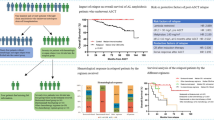Abstract
High-dose melphalan chemotherapy and autologous peripheral blood stem cell transplantation (HDM/SCT) has been shown to result in a durable hematologic response and prolonged overall survival in systemic amyloid light-chain (AL) amyloidosis as well as multiple myeloma. However, little is known about the myeloma associated with AL amyloidosis (MM/AL). In this retrospective study, we evaluated 87 patients with MM/AL from 1994 to 2007. Sixteen of these patients underwent HDM/SCT at Boston University Medical Center. Three patients (19%) died from treatment-related mortality. The overall median survival for all 87 patients was 22 months by Kaplan–Meier estimates. However, this was improved to 54.5 months for those who received HDM/SCT compared to 21 months for those who did not receive HDM/SCT. A hematologic complete response was achieved by 25% (4/16) of patients at 6 months after HDM/SCT. Hematologic relapses occurred in 60% of patients at a median of 1 year after HDM/SCT. In conclusion, HDM/SCT can prolong overall survival in patients with MM/AL who are eligible to receive it.


Similar content being viewed by others
References
Bahlis NJ, Lazarus HM (2006) Multiple myeloma-associated AL amyloidosis: is a distinctive therapeutic approach warranted? Bone Marrow Transplant 38:7–15
Gertz MA, Lacy MQ, Dispenzeiri A (1999) Amyloidosis. Hematol Oncol Clin North Am 13:1211–1220
Blade J, Rosinol L, Sureda A et al (2005) High-dose therapy intensification compared with continued standard chemotherapy in multiple myeloma patients responding to the initial chemotherapy: long-term results from a prospective randomized trial from the Spanish cooperative group PETHEMA. Blood 106:3755–3759
Attal M, Harousseau JL, Stoppa AM et al (1996) A prospective, randomized trial of autologous bone marrow transplantation and chemotherapy in multiple myeloma. Intergroupe Francais du Myelome. N Engl J Med 335:91–97
Child JA, Morgan GJ, Davies FE et al (2003) High-dose chemotherapy with hematopoietic stem-cell rescue for multiple myeloma. N Engl J Med 348:1875–1883
Gertz MA, Lacy MQ, Dispenzieri A, Hayman SR, Kumar S (2007) Transplantation for amyloidosis. Curr Opin Oncol 19:136–141
Sanchorawala V, Wright DG, Seldin DC et al (2001) An overview of the use of high-dose melphalan with autologous stem cell transplantation for the treatment of AL amyloidosis. Bone Marrow Transplant 28:637–642
Skinner M, Sanchorawala V, Seldin DC et al (2004) High-dose melphalan and autologous stem-cell transplantation in patients with AL amyloidosis: an 8-year study. Ann Intern Med 140:85–93
Sanchorawala V, Skinner M, Quillen K, Finn KT, Doros G, Seldin DC (2007) Long-term outcome of patients with AL amyloidosis treated with high-dose melphalan and stem-cell transplantation. Blood 110:3561–3563
Sanchorawala V, Wright DG, Seldin DC et al (2004) High-dose intravenous melphalan and autologous stem cell transplantation as initial therapy or following two cycles of oral chemotherapy for the treatment of AL amyloidosis: results of a prospective randomized trial. Bone Marrow Transplant 33:381–388
Perz JB, Schonland SO, Hundemer M et al (2004) High-dose melphalan with autologous stem cell transplantation after VAD induction chemotherapy for treatment of amyloid light chain amyloidosis: a single centre prospective phase II study. Br J Haematol 127:543–551
Gertz MA, Comenzo R, Falk RH et al (2005) Definition of organ involvement and treatment response in immunoglobulin light chain amyloidosis (AL): a consensus opinion from the 10th International Symposium on Amyloid and Amyloidosis, Tours, France, 18–22 April 2004. Am J Hematol 79:319–328
Merlini G, Bellotti V (2003) Molecular mechanisms of amyloidosis. N Engl J Med 349:583–596
Vela-Ojeda J, Garcia-Ruiz Esparza MA, Padilla-Gonzalez Y et al (2009) Multiple myeloma-associated amyloidosis is an independent high-risk prognostic factor. Ann Hematol 88:59–66
International Myeloma Working Group (2003) Criteria for the classification of monoclonal gammopathies, multiple myeloma and related disorders: a report of the International Myeloma Working Group. Br J Haematol 121:749–757
Acknowledgments
This clinical research was supported by grants from the National Institutes of Health (P01 HL68705), the Gerry Foundation, and the Amyloid Research Fund at Boston University.
Author information
Authors and Affiliations
Corresponding author
Rights and permissions
About this article
Cite this article
Girnius, S., Seldin, D.C., Skinner, M. et al. Short and long-term outcome of treatment with high-dose melphalan and stem cell transplantation for multiple myeloma-associated AL amyloidosis. Ann Hematol 89, 579–584 (2010). https://doi.org/10.1007/s00277-009-0874-8
Received:
Accepted:
Published:
Issue Date:
DOI: https://doi.org/10.1007/s00277-009-0874-8




